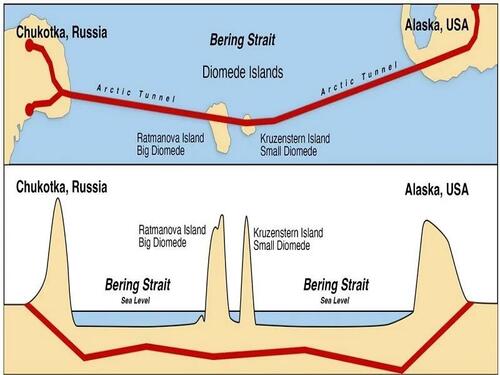Authored by Andrew Korybko via Substack,
Russia might still fund some less ambitious infrastructure projects in its Far East-Arctic region to keep the economy hot after the war ends, help veterans find work, and encourage settlement there...
Trump reacted positively to the proposal by Kirill Dmitriev, chief of the Russian Direct Investment Fund and envoy in ongoing negotiations with the US, to build a tunnel beneath the Bering Strait. The idea isn’t new but has recently been revived as a means of physically embodying the New Détente that their leaders aim to achieve if they’re first able to end the Ukrainian Conflict. Given its $8-65 billion cost as estimated by Dmitriev himself, however, this megaproject would have to be profitable if it’s to be built.
Therein lies the problem since Russian-US trade has always been low even before the unprecedented sanctions that were imposed after the start of the special operation. Energy and raw materials comprise the vast majority of Russian exports, but the US doesn’t need them since it already has enough of pretty much everything apart from rare earth minerals. About that, while Russia has some untapped rare earth deposits, their yields could easily be exported to the US by sea in the event of a New Détente.
Two Russian experts recently interviewed by publicly financed TASS are of a similar opinion.
According to Dmitry Zavyalov, head of the Department of Entrepreneurship and Logistics and dean of the Higher School of Economics faculty at the Plekhanov Russian University of Economics, China might be interested in this megaproject, but “the scale of the costs, their distribution among the project participants, and geopolitical risks reduce the potential benefits.”
Alexander Firanchuk, a leading researcher at the Presidential Academy’s International Laboratory for Foreign Trade Research, pointed out that “Alaska is cut off from the main US rail network, while Chukotka is thousands of kilometers of permafrost and mountains from the nearest Russian rails. Any ‘saving’ of a couple of days’ travel compared to the sea instantly vanishes against the monstrous costs of building thousands of kilometers of new tracks, bridges, and tunnels in the harshest climates on the planet.”
Nevertheless, the aforesaid infrastructure projects might also be what Dmitriev has in mind, perhaps envisaged as a Russian version of FDR’s “New Deal” for keeping the economy hot and helping veterans find work once the war ends.
Putin recently approved high-speed rail projects for connecting Moscow with major cities in European Russia, which could be employed to this end, but the tunnel proposal would help develop and settle the Far East-Arctic region per the vision that he shared in September.
Putin also proposed building a new veteran-led Russian elite last year, and some of its most aspirational members could cut their political teeth by working on these projects and then running in regional elections, after which they might rise to national renown. Among the comparatively less aspirational majority, they might be content to live out their lives in the rural Far East-Arctic region after working on projects there, especially if they were traumatized by the war and struggle to reintegrate into society.
With this insight in mind, the Bering Strait tunnel idea that Dmitriev just revived would actually be quite beneficial to Russia, but not for the reasons that many might have assumed. Even so, the total costs of this megaproject and all the associated infrastructure that would have to be built in the Far East-Arctic region would be enormous and arguably beyond the national budget’s means to fund in full, and foreign investors might not consider any of this to be profitable. The tunnel might thus remain a pipe dream.
Loading recommendations...
